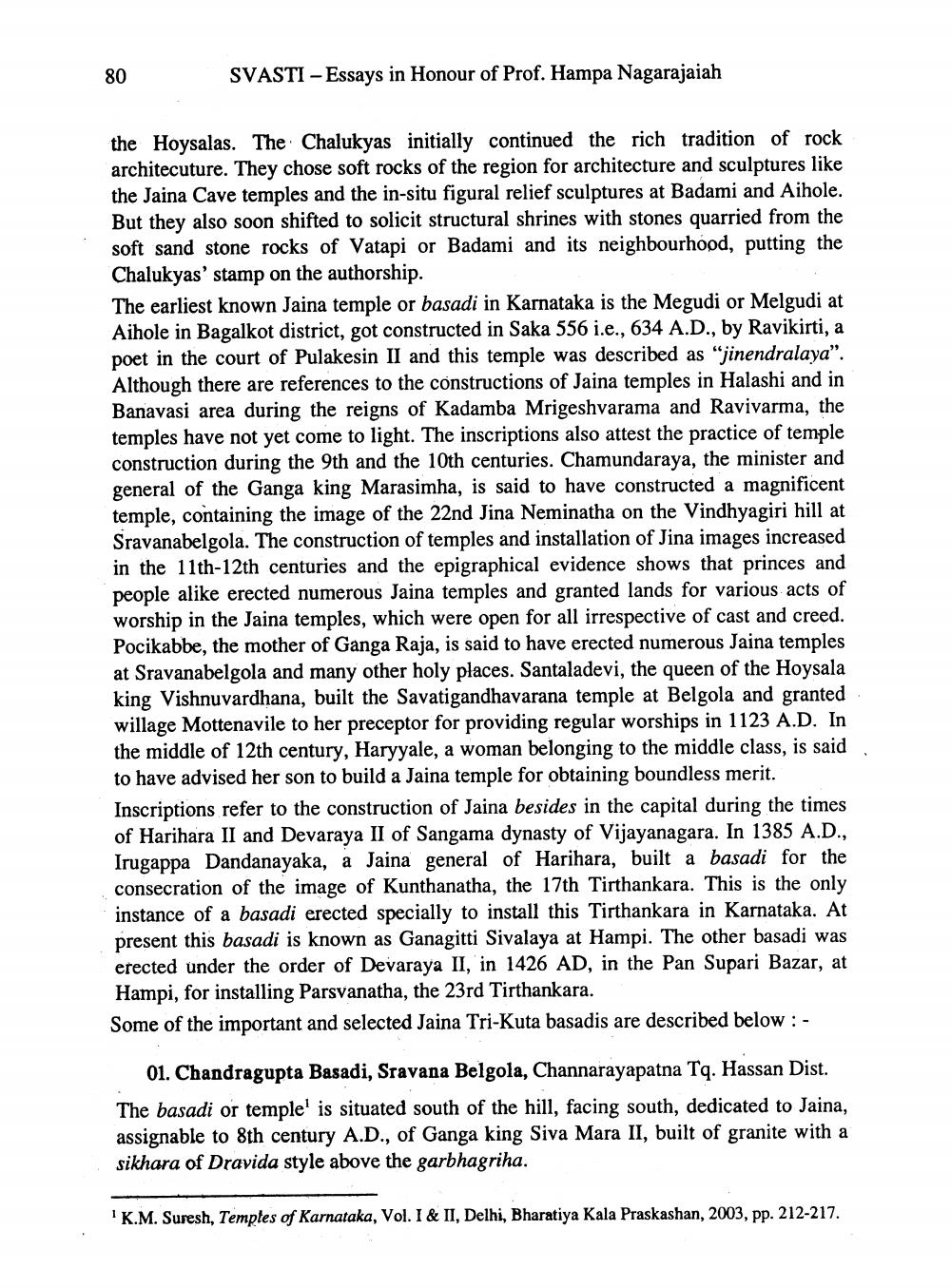________________
80
SVASTI - Essays in Honour of Prof. Hampa Nagarajaiah
the Hoysalas. The Chalukyas initially continued the rich tradition of rock architecuture. They chose soft rocks of the region for architecture and sculptures like the Jaina Cave temples and the in-situ figural relief sculptures at Badami and Aihole. But they also soon shifted to solicit structural shrines with stones quarried from the soft sand stone rocks of Vatapi or Badami and its neighbourhood, putting the Chalukyas' stamp on the authorship. The earliest known Jaina temple or basadi in Karnataka is the Megudi or Melgudi at Aihole in Bagalkot district, got constructed in Saka 556 i.e., 634 A.D., by Ravikirti, a poet in the court of Pulakesin II and this temple was described as "jinendralaya”. Although there are references to the constructions of Jaina temples in Halashi and in Banavasi area during the reigns of Kadamba Mrigeshvarama and Ravivarma, the temples have not yet come to light. The inscriptions also attest the practice of temple construction during the 9th and the 10th centuries. Chamundaraya, the minister and general of the Ganga king Marasimha, is said to have constructed a magnificent temple, containing the image of the 22nd Jina Neminatha on the Vindhyagiri hill at Sravanabelgola. The construction of temples and installation of Jina images increased in the 11th-12th centuries and the epigraphical evidence shows that princes and people alike erected numerous Jaina temples and granted lands for various acts of worship in the Jaina temples, which were open for all irrespective of cast and creed. Pocikabbe, the mother of Ganga Raja, is said to have erected numerous Jaina temples at Sravanabelgola and many other holy places. Santaladevi, the queen of the Hoysala king Vishnuvardhana, built the Savatigandhavarana temple at Belgola and granted willage Mottenavile to her preceptor for providing regular worships in 1123 A.D. In the middle of 12th century, Haryyale, a woman belonging to the middle class, is said to have advised her son to build a Jaina temple for obtaining boundless merit. Inscriptions refer to the construction of Jaina besides in the capital during the times of Harihara II and Devaraya II of Sangama dynasty of Vijayanagara. In 1385 A.D., Irugappa Dandanayaka, a Jaina general of Harihara, built a basadi for the consecration of the image of Kunthanatha, the 17th Tirthankara. This is the only instance of a basadi erected specially to install this Tirthankara in Karnataka. At present this basadi is known as Ganagitti Sivalaya at Hampi. The other basadi was erected under the order of Devaraya II, in 1426 AD, in the Pan Supari Bazar, at Hampi, for installing Parsvanatha, the 23rd Tirthankara. Some of the important and selected Jaina Tri-Kuta basadis are described below:
01. Chandragupta Basadi, Sravana Belgola, Channarayapatna Tq. Hassan Dist. The basadi or temple' is situated south of the hill, facing south, dedicated to Jaina, assignable to 8th century A.D., of Ganga king Siva Mara II, built of granite with a sikhara of Dravida style above the garbhagriha.
K.M. Suresh, Temples of Karnataka, Vol. I & II, Delhi, Bharatiya Kala Praskashan, 2003, pp. 212-217.




